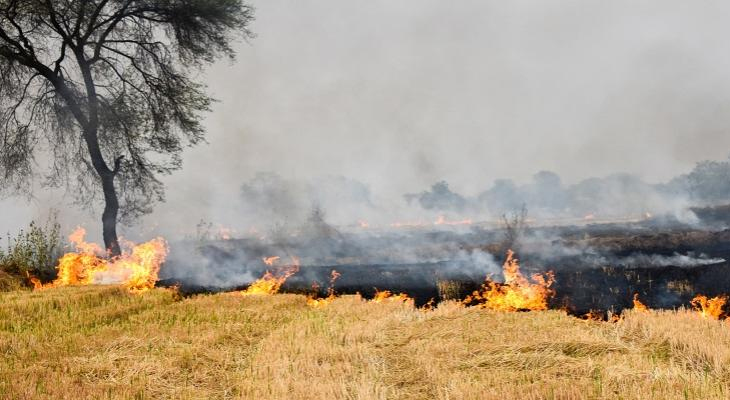News Highlight
The Indian Agricultural Research Institute (IARI) says stubble burning in Punjab is at a three-year low.
Key Takeaway
- The Centre had undertaken a review meeting with States ahead of the crop-burning season.
What is stubble burning?
- Stubble is the remaining part of paddy, which has roots in the earth.
- Stubble burning is intentionally setting fire to crop residue (stubble) to remove it from the field to prepare the area for the next crop.
Reasons for stubble burning
- Reduced Use of Stubble:
- Farmers used stubble as hay to keep animals or homes warm and even for cooking. However, these uses of stubble have now become outdated.
- The Mechanisation of Agriculture:
- Mechanised harvesting extracts the rice grains, leaving a huge residue behind. Manual harvesting is not an option for farmers because of the huge labour charges and the increased time taken.
- Lack of awareness:
- Farmers are not realising that they are burning the soil’s friendly insects and organic matter and causing considerable loss of nitrogen and Potassium.
- Alternatives are expensive:
- The Happy Seeder is a tractor-mounted machine that cuts and lifts rice straw, sows wheat into the bare soil, and deposits the straw over the sown area as mulch.
- To use a ‘happy seeder’ machine, farmers have to shell out Rs. 1000 per acre of land as machine rent and a further Rs. 2000 for diesel.
Effects of stubble burning
- Air Pollution:
- Open stubble burning emits large amounts of toxic pollutants into the atmosphere, which contain harmful gases like methane (CH4), carbon monoxide (CO), volatile organic compounds (VOC), and carcinogenic polycyclic aromatic hydrocarbons.
- Burning farm residue is one of the significant causes of air pollution in parts of north India, deteriorating the air quality.
- Stubble burning by farmers in Haryana, western Uttar Pradesh, and Punjab in north India is considered a significant cause of air pollution in Delhi and its adjoining regions.
- Soil Fertility:
- Burning husk on the ground destroys the nutrients in the soil, making it less fertile.
- Heat Penetration:
- The heat generated by stubble burning penetrates the soil, losing moisture and valuable microbes.
- Lung diseases:
- Pollution from stubble burning significantly reduced lung function and harmed women, children, and the elderly.
Initiatives to control Stubble Burning
- Government funding:
- Under a 100% centrally-funded scheme, in-situ residue management machines are given to individual farmers at a 50% subsidy and CHCs (custom hiring centres) at an 80% subsidy.
- The Turbo Happy Seeder machine:
- The Turbo Happy Seeder (THS) machine can uproot the stubble and sow seeds in the cleared area. The stubble can then be used as mulch for the field.
Way forward
- Utilising Crop Stubble:
- Instead of burning the stubble, it can be used in different ways, like cattle feed, compost manure, roofing in rural areas, biomass energy, mushroom cultivation, packing materials, fuel, paper, bio-ethanol, industrial production, etc.
- Farmer’s Education:
- Farmers have difficulty unlearning the practice of stubble burning, and they should be educated about its ill effects and offered attractive alternatives.
- The long-term solution:
- The long-term solution has to be crop diversification away from paddy. Encourage farmers to sow alternate crops and shift them away from paddy to maise, fruits, vegetables, and cotton.
- Government Incentives:
- The government should also subsidise or incentivise the industries engaged in converting stubble into economically viable products.
- Chhattisgarh Model:
- An innovative experiment has been undertaken by the Chhattisgarh government by setting up gauthans.
- A gauthan is a dedicated five-acre plot, held in common by each village, where all the unused stubble is collected through parali daan (people’s donations) and is converted into organic fertiliser by mixing with cow dung and a few natural enzymes.
Indian Agricultural Research Institute (IARI)
- History:
- It, popularly known as Pusa Institute, began in 1905 at Pusa (Bihar) with a generous grant of 30,000 pounds from an American philanthropist, Mr Henry Phipps.
- The institute was then known as Agricultural Research Institute (ARI), which functioned with five departments, namely.
- Agriculture
- Cattle Breeding,
- Chemistry
- Economic Botany
- Mycology.
- Foundation:
- The name of ARI was changed to the Imperial Institute of Agricultural Research in 1911, and in 1919, it was renamed Imperial Agricultural Research Institute.
- Post-independence, the institute was renamed the Indian Agricultural Research Institute (IARI).
Content Source: The Hindu



